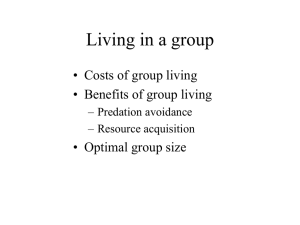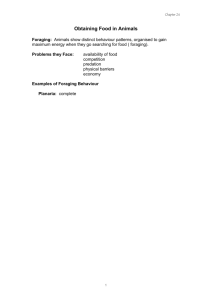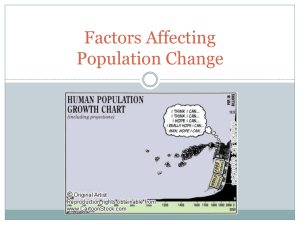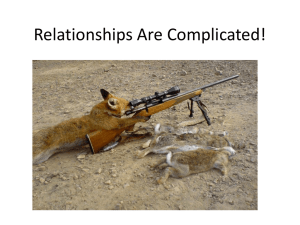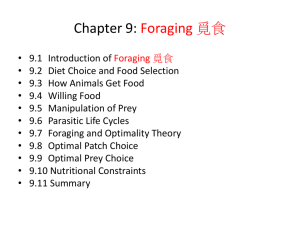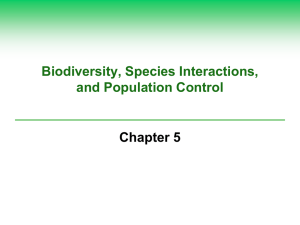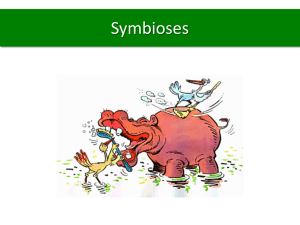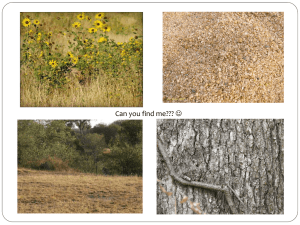Predation 1
advertisement
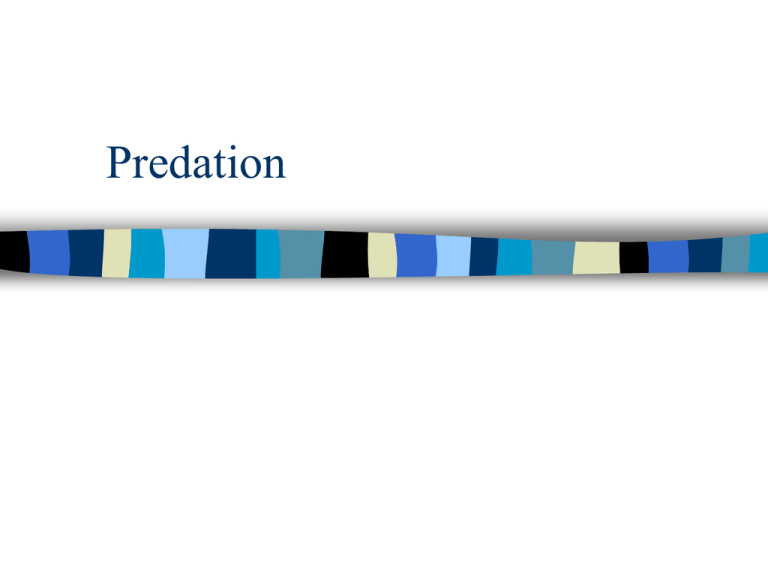
Predation Hypotheses for Patterns of Diversity Evolutionary Time Ecological Time Primary Production Stability of Primary Production Structural (Habitat) Diversity Climatic Stability Competition Predation Predation In an ecological sense, predation is not just carnivores like wolves eating musk oxen, or coyotes eating mice. In fact, deer are acting as predators on plants, parasites act as predators on their hosts, and mice act as predators on the seeds they eat. The difference here is in the extent of the effect. Predation Carnivory – capture, kill, and consume an animal. Herbivory – consumption of plant material by an animal. – – – – – Grazer/folivore consumes leafy material Browser consumes woody material and bark. Granivore consumes seeds Frugivore consumes fruit Exudivore consumes exudates like sap. Predation Parasitism – association w/ host. Objective is to keep host alive. Generally, parasite stays with same host throughout its life. Parasitoids – parasitic activities limited to larval stages. Predation Carnivorous predation: – predator must locate, capture, and consume prey. – Mammalian predators employ a diversity of morphological, physiological, and behavioral techniques to to this. – Reptilian predators do this as well. Compare a monitor lizard with a snake. Predation Prey detection and recognition – Search image. – Smell - chemoreception – Sound - bats and marine carnivores. Prey capture – Stalk and ambush – Finess. – Pure power. Prey Adaptations Avoiding detection – Crypsis Avoiding capture – Herd behavior in ungulates = safety in numbers and increased vigilance. – Detection of predator as in kangaroo rats. – High speed locomotion, or use of refugium. – Display as in baboons. – Chemical defense as in skunks and toads. – Body armor as in turtles. Herbivorous Predation Herbivores use a variety of devices to improve efficiency: – Pectinate teeth in dermopterans. – Thumb in giant panda – Elongated intestines and ceacum and/or ruminant stomach. Plant Adaptations to Herbivores Chemical defenses such as tanins – Grey and fox squirrels and red and black oak acorns. Synchronous flowering or seed set ‘swamps’ potential herbivores – safety in numbers. Structural adaptations – spines in cacti and euphorbs. Effects of Herbivory For the most part, herbivory is not good for the plant. However, Grazing may increase production in some cases. Optimal Foraging Predators are under intense selection pressure to find and consume prey. We expect that organisms should forage in a way that optimizes their inclusive fitness. How can this be done? 2 ways: Energy Maximizers and Time Minimizers. Optimal Foraging Energy maximizers: Get maximum possible energy return under a given set of foraging conditions – EMs get the maximum amount of energy possible. Time minimizers: Get maximum possible energy return under a given set of foraging conditions – TMs obtain a given amount of energy in the min. amt. of time. Optimal Diet There is a trade-off between a specialized diet and a generalized one: – Specialized diet: food items are of high value, but may require extensive search energy or search time. These items may also require extensive handling. – Generalized diet: food items may be more abundant, but will not be of equal value. Optimal Foraging Each item consumed contributes to the average energy input. The better diet is the one that increases the average energy input. The question becomes, should the organism broaden its diet or narrow its diet? Optimal Foraging Energy input per item can be written as: Ei hi Optimal Foraging In this formulation, we compare the caloric content of each item, to the handling time (or energy) required to capture, subdue, and consume that item. Lets create a model that will allow us to predict what an organism should do. Optimal Foraging Define the amount of time spent searching for prey as Ts seconds. Our predator encounters 2 types of prey at rates 1 and 2 prey per second. These prey items contain E1 and E2 calories, and take h1 and h2 seconds to handle. Optimal Foraging If the predator spends Ts seconds searching for prey, it will encounter: n1 = Ts 1 type 1 prey n2 = Ts 2 type 2 prey Optimal Foraging The total energetic return, E, will be equal to the number of encounters times their respective energetic contents. E = n1E1 + n2E2 Optimal Foraging The total time spent handling these prey items will be: Th = n1h1 + n2h2 Optimal Foraging Substituting for n1 and n2, we get: E Ts 1 E1 Ts 2 E2 E Ts 1 E1 2 E2 Optimal Foraging The total time spent handling prey is given by: Th Ts 1h1 Ts 2 h2 Th Ts ( 1h1 2 h2 ) Optimal Foraging So, the total time spent searching for and handling prey will be: T Ts Th T Ts Ts 1h1 2 h2 Optimal Foraging And the energetic return per unit time spent searching for and handling prey becomes: T ( E E ) s 1 1 2 2 E T T T h h s s 1 1 2 2 Optimal Foraging This simplifies to: E E 1 1 2 2 E T 1 h h 1 1 2 2 Optimal Foraging Try an example. Suppose our optimal forager has 100 seconds to search for prey. It encounters prey type 1 at a rate of 0.10/s, and prey type 2 at 0.01/s. Thus, 1 = 0.1 2 = 0.01 Optimal Foraging Also, prey type 1 contains 10 calories and takes 5 seconds to handle, while prey type 2 contains 10 calories and takes 10 seconds to handle. E1 = 10 E2 = 10 h1 = 5 h2 = 10 Should our predator be a generalist or a specialist? Marginal Value Theorem Marginal Value Theorem
